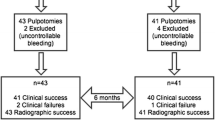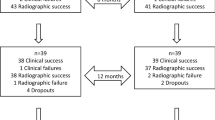Abstract
Aim
To compare the clinical and radiographic success rates of three different pulpotomy agents in primary molars after 18 months.
Methods
The study was carried out with 51 primary molars of children aged 5–9 years old. The teeth were randomly assigned to the experimental or control groups. After coronal pulp removal and haemostasis, the remaining pulp tissue was covered with Biodentine® or mineral trioxide aggregate in the experimental groups. In the control group, formocresol was placed with a cotton pellet over the pulp tissue for 5 min and after removal the pulp tissue was covered with zinc oxide–eugenol (ZOE) paste. All teeth were immediately restored with reinforced ZOE base and resin modified glass-ionomer cement, and later with pre-formed metal crowns. Follow-up assessments were carried out after 3, 6, 12 and 18 months.
Results
Forty-five teeth were available for follow up at the end of 18 months. All of the available teeth for mineral trioxide aggregate and Biodentine® were clinically successful, as were 73.3% of the FC group. Radiographic success rate for the formocresol group at 18 months follow up was 73.3, 100% for mineral trioxide aggregate and 86.6% for Biodentine® group.
Conclusion
Mineral Trioxide aggregate and Biodentine® showed more favourable results than formocresol.


Similar content being viewed by others
References
Airen P, Shigli A, Airen B. Comparative evaluation of formocresol and mineral trioxide aggregate in pulpotomised primary molars—2 year follows up. J Clin Pediatr Dent. 2012;37:143–7.
Ansari G, Ranjpour M. Mineral trioxide aggregate and formocresol pulpotomy of primary teeth: a 2-year follow-up. Int Endod J. 2010;43:410–8.
Bharti K, Kumar R, Khanna R. Clinical and radiographical evaluation of mineral trioxide aggregate, biodentine and propolis as pulpotomy medicaments in primary teeth. Restor Dent Endod. 2015;40(4):276–85.
Camilleri J. Investigation of Biodentine as dentine replacement material. J Dent. 2013;41(7):600–10.
Eidelman E, Odont, Holan G, Fuks AB. Mineral trioxide aggregate vs. formocresol in pulpotomised primary molars: a preliminary report. Pediatr Dent 2001; 23:15–18.
Erdem AP, Guven Y, Balli B, et al. Success rates of mineral trioxide aggregate, ferric sulphate, and formocresol pulpotomies: a 24-month study. Pediatr Dent. 2011;33(2):165–70.
Fuks AB, Holan G, Davis JM, Eidelman E. Ferric sulfate versus dilute formocresol in pulpotomised primary molars: long-term follow up. Pediatr Dent. 1997;19:327–30.
Guelmann M, Bookmyer K, Villalta P, García-Godoy F. Microleakage of restorative techniques for pulpotomized primary molars. J Dent Child. 2004;71:209–11.
Heilig J, Yates J, Siskin M, Mcknight J, Turner J. Calcium hydroxide pulpotomy for primary teeth: a clinical study. J Am Dent Assoc. 1984;108:775–8.
Hicks MJ, Barr ES, Flaitz CM. Formocresol pulpotomy in primary molars: a radiographic study in pediatric dentistry. J Pedod. 1986;10:331–9.
Holan G, Eidelman E, Fuks AB. Long-term evaluation of pulpotomy in primary molars using mineral trioxide aggregate or formocresol. Pediatr Dent. 2005;27:129–36.
Huth KC, Paschos E, Hajek-Al-Khatar N, et al. Effectiveness of 4 pulpotomy techniques: a randomized controlled trial. J Dent Res. 2005;84:1144–8.
Jose B, Ratankumari N, Mohanty M, Varma HK, Komath M. Calcium phosphate cement as an alternative for formocresol in primary teeth pulpotomies. Indian J Dent Res. 2013;24(4):522.
Kalaskar RR, Damle SG. Comparative evaluation of lyophilized freeze dried platelet derived preparation with calcium hydroxide as pulpotomy agents in primary molars. J Indian Soc Pedod Prev Dent. 2004;22(1):24–9.
Koubi S, Elmirini H, Koubi G, Tassery H, Camps J. Quantitative evaluation by diffusion of micro leakage in aged calcium silicate based open sandwich restorations. Int J Dent. 2012;2:1–6.
Marghalani AA, Omar S, Chen JW. Clinical and radiographic success of mineral trioxide aggregate compared with formocresol as a pulpotomy treatment in primary molars: a systematic review and meta-analysis. J Am Dent Assoc. 2014;145(7):714–21.
Moretti AB, Sakai VT, Oliveria TM, et al. The effectiveness of mineral trioxide aggregate, calcium hydroxide and formocresol for pulpotomies in primary teeth. Int Endod J. 2008;41:547–55.
Niranjani K, Prasad MG, Vasa AAK, et al. Clinical evaluation of success of primary teeth pulpotomy using mineral trioxide aggregate, laser and biodentine an in vivo study. J Clin Diagn Res. 2015;9:35–7.
Oliveria TM, Moretti ABS, Sakai VT, et al. Clinical, radiographic and histologic analysis of the effects of pulp capping materials used in pulpotomies of human primary teeth. Eur Arch Pediatr Dent. 2013;14:65–71.
Parisey I, Ghoddusi J, Forghani M. A review on vital pulp therapy in primary teeth. Iran Endod J. 2015;10(1):6–15.
Raskin A, Eschrich G, Dejou J, About I. In vitro microleakage of Biodentine as a dentin substitute compared to Fuji II LC in cervical lining restorations. J Adhes Dent. 2012;14(6):535–42.
Shabzendedar M, Mazhari F, Alami M, Talebi M. Sodium hypochlorite vs. formocresol as pulpotomy medicaments in primary molars: 1 year follow up. Pediatr Dent. 2013;35(4):329–32.
Simancas-Pallares MA, Diaz-Caballero AJ, Luna-Ricardo LM. Mineral trioxide aggregate in primary teeth pulpotomy. A systematic literature review. Med Oral Patol Oral Cir Bucal. 2010;15(8):942–6.
Smaïl-Faugeron V, Courson F, Durieux P, et al. Pulp treatment for extensive decay in primary teeth. Cochrane Database Syst Rev. 2014;6(8):CDOO322O.
Soundappan S, Sundaramurthy JL, Natanasabapathy V. Biodentine vs. mineral trioxide aggregate vs. intermediate restorative material for retrograde root end filling: an invitro study. J Dent. 2014;11:143–9.
Vidya KB, Patil SB, Anegundi RT. Is pulpotomy obsolete? A clinical study on the success rates of indirect pulp capping, and pulpotomy in the treatment of deep dentinal caries in primary second molars. J Int Clin Dent Res Organ. 2015;7:24–9.
Walker LA, Sanders BJ, Jones JE, et al. Current trends in pulp therapy: a survey analyzing pulpotomy techniques taught in paediatric dental residency programs. J Dent Child. 2013;80(1):31–5.
Waterhouse PJ, Nunn JH, Whitworth JM. An investigation of the relative efficacy of Buckley’s formocresol and calcium hydroxide in primary molar vital pulp therapy. Br Dent J. 2000;188(1):32–6.
Author information
Authors and Affiliations
Corresponding author
Ethics declarations
Funding
The study was self-funded.
Conflict of interest
The authors declares that there is no competing interest.
Ethical approval
Humans were involved in this study. All the procedures performed in the study involving human participants were in accordance with the ethical standards of the institution.
Informed consent
Informed consent was obtained from all the individual participants included in the study.
Rights and permissions
About this article
Cite this article
Juneja, P., Kulkarni, S. Clinical and radiographic comparison of biodentine, mineral trioxide aggregate and formocresol as pulpotomy agents in primary molars. Eur Arch Paediatr Dent 18, 271–278 (2017). https://doi.org/10.1007/s40368-017-0299-3
Received:
Accepted:
Published:
Issue Date:
DOI: https://doi.org/10.1007/s40368-017-0299-3




